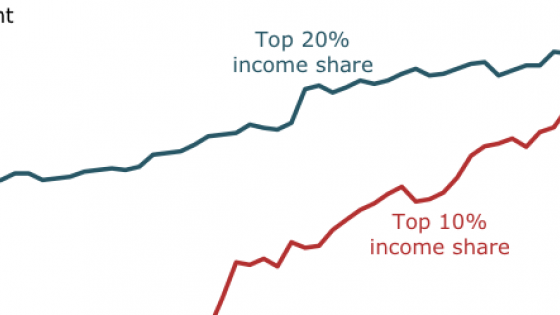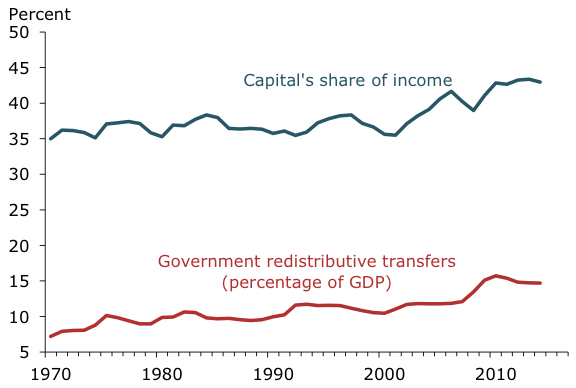Income inequality in the US has increased dramatically in recent decades. Most of the increase can be traced to gains going to those near the top of the income distribution. As emphasised by Piketty (2014: 297), from 1977 to 2007 three-quarters of the income growth in the US economy went to the top 10% of households.
Figure 1 shows the dramatic climb in the share of before-tax income (excluding capital gains) going to the top 10% of US households ranked by income. This share increased from 32% in 1970 to 47% in 2014. The corresponding income share for the top 20% of households rose from 43% in 1970 to 51% in 2014. The faster rise of the income of the top 10% share reflects the disproportionate gains of the highest earners.
Figure 1 US before-tax income shares
Source: Census Table (Table H-2), World Top Incomes database.
Another way to track income is by source. Labour income includes wages and other types of employee compensation. Capital income includes corporate profits, rental income and net interest income. Figure 2 shows that the share of total income from capital sources increased from 35% in 1970 to 43% in 2014. During this period, the top 20% of households ranked by income owned more than 90% of total financial wealth (Wolf 2010). Given this highly skewed wealth distribution, the increase in capital’s share of income would be expected to disproportionately benefit households in the top 20% of the income distribution. But as a mitigating factor, Figure 2 also shows that government transfer payments to individuals approximately doubled, rising from about 7% of GDP in 1970 to nearly 15% in 2014. These transfer payments primarily redistribute income through various social programs, including disability and unemployment insurance, Medicare and Medicaid, and food stamps. As such, these transfers should disproportionately benefit households in the bottom 80% of the income distribution.
Figure 2 Capital’s share of income and government transfers
Note: Capital's share of income is measured as 1 minus the ratio of employee compensation to gross value-added of the corporate business sector.
Source: Bureau of Economic Anlaysis (NIPA Table 1.14), FRB St. Louis FRED database.
Causes of rising inequality
There are numerous theories about the underlying causes of rising income inequality (Dabla-Norris et al. 2015). Theories involving ‘skill-biased technological change’ emphasise the relentless shift in the ways businesses produce and distribute goods and services – a shift that raises the relative demand and wages for highly skilled and highly educated workers. Alternative theories emphasise the forces of globalisation and the expansion of the financial sector, which have contributed to the ‘offshoring’ of production and other investments designed to reduce labour costs. Finally, theories based on institutional change emphasise the decline of labour unions and the rise of stock option-based executive compensation that have contributed to an environment where earnings at the top have been pushed well above historical norms (Piketty et al.2014).
Modeling strategy
In a recent paper, we use a quantitative economic model to gauge the consumption gains or losses that result from the pattern of rising US income inequality (Lansing and Markiewicz 2018). We compare consumption in the actual scenario with rising inequality and transfers to consumption in a hypothetical alternative scenario in which inequality and transfers do not increase. Specifically, the alternative scenario holds household income shares and government transfers relative to output at their 1970 levels. The results indicate that the increase in income inequality since 1970 has delivered large consumption gains to households in the top 20% of the income distribution. But for households outside of this exclusive group, the consumption losses relative to the alternative scenario appear to have been significant, albeit substantially mitigated by the large increase in government redistributive transfers since 1970.
Analysing other scenarios shows that a relatively modest boost in the historical growth rate of redistributive transfers, accompanied by modestly higher average tax rates, could have achieved small but equal consumption gains for households throughout the income distribution.
Our model allows us to split aggregate US consumption expenditures into the implied consumption paths for two groups: (1) households in the top 20% of the income distribution; and (2) households in the bottom 80% of the distribution. We compute the consumption gain or loss by comparing each group’s consumption path to a hypothetical alternative scenario that holds income shares and redistributive transfers at their 1970 levels. For households in the top income group, our results indicate that the increase in income inequality has delivered a gain that is equivalent to a 3% increase in annual consumption every year in perpetuity. By contrast, each household outside the top income group has suffered a loss that is equivalent to a 1% drop in annual consumption every year in perpetuity.
Importance of redistributive transfers
If the ratio of transfers to output were held at the 1970 level but income inequality continued to rise as before, the consumption loss for each household outside the top income group would be magnified by a factor of nine. In other words, each household in this group would now suffer a loss that is equivalent to a 9% drop in annual consumption every year in perpetuity. This result shows that the historical pattern of rising US transfer payments has done much to mitigate the negative impacts of rising income inequality for households outside of the top income group.
We also use the model to determine how transfers would have needed to grow to deliver equal gains to both groups of households. We find that the ratio of transfers to output would have needed to increase faster, reaching 19% by 2014 versus the actual value of 15% in the data. In this case, the consumption gain for both groups turns out to be quite small. This is due to the need for higher tax rates to finance the faster transfer growth. But these higher tax rates would still be near the low end of the range of average tax rates among OECD countries (Piketty and Saez 2013). Moreover, while the resulting gains may be small, the scenario still represents a significant improvement (relative to what actually happened) for households outside of the top income group.
Conclusion
The increase in US income inequality over the past half-century can be traced to gains made by those near the top of the income distribution – where financial wealth and corporate stock ownership is highly concentrated. The economic and political implications of this pattern of rising inequality have garnered substantial attention among researchers and policymakers. Overall, our results suggest that there is room for policy actions that could offset the negative consequences of rising income inequality.
References
Dabla-Norris, E, K Kochhar, N Suphaphiphat, F Ricka and E Tsounta (2015), “Causes and consequences of income inequality: A global perspective”, International Monetary Fund Staff Discussion Note 15/13 (June).
Lansing, K J and A Markiewicz (2018), “Top incomes, rising inequality, and welfare”, Economic Journal 128: 262-297.
Piketty, T (2014), Capital in the twenty-first century, Cambridge: Harvard University Press.
Piketty, T and E Saez (2013), “Optimal labour income taxation”, in Handbook of Public Economics, volume 5, eds. Auerbach, A J, R Chetty, M Feldstein and E Saez, Amsterdam: Elsevier, pp. 391-474.
Piketty, T, E Saez and S Stantcheva (2014), “Optimal taxation of top labour incomes: A tale of three elasticities”, American Economic Journal: Economic Policy 6(1): 230-271.
Wolff, E N (2010), “Recent trends in household wealth in the United States: Rising debt and the middle-class squeeze – an update to 2007”, Levy Economics Institute Working Paper 589.





